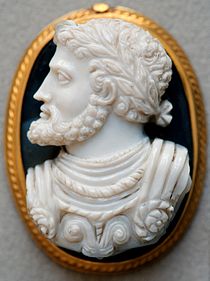Battle of the Sesia (1524)
| Battle of the Sesia | |||||||
|---|---|---|---|---|---|---|---|
| Part of the Italian War of 1521–1526 | |||||||
| |||||||
| Belligerents | |||||||
|
| |||||||
| Commanders and leaders | |||||||
|
Guillaume Gouffier Pierre Terrail † | Charles de Lannoy | ||||||
The Battle of the Sesia or Battle of the Sesia River, took place near the Sesia River (Latin: Sesites or Sessite), situated in north-western Italy, Lombardy, on 30 April 1524, where the Spanish-Imperial forces commanded by Don Carlos de Lannoy, inflicted a decisive defeat[1][2] to the French forces under the Admiral Guillaume Gouffier, Lord of Bonnivet and Francis de Bourbon, Comte de St. Pol, during the Italian War of 1521–1526.[1][2][3][4]
Bonnivet's offensive of 1523–1524
The French, in possession of the Italian region of Lombardy at the start of the Italian War of 1521–1526, had been forced to abandon it after their defeat at the Battle of Bicocca in 1522.Cite error: The <ref> tag has too many names (see the help page). Determined to regain it, Francis I of France ordered an invasion of the region in October 1523, with an army of 18,000 men commanded by Guillaume Gouffier, Lord of Bonnivet.[3] The French army advanced through the Piedmont to Novara, where it was joined by a similarly sized force of Swiss mercenaries.[3] Prospero Colonna, who had only 9,000 men to oppose the French advance, finally decided to retreat to Milan.[3]
Bonnivet, however, overestimated the size of the Spanish-Imperial army and moved into winter quarters rather than attacking the city. This allowed the commanders of Emperor Charles to summon 15,000 landsknechts and a large Spanish force under Charles of Bourbon's command. By December 28, when Charles de Lannoy replaced Colonna, Bonnivet had begun his withdrawal.[5]
Battle of the Sesia


The forces of Charles de Lannoy and of Guillaume Gouffier clashed near the Sesia River, on 30 April, when the Spanish-Imperial troops intercepted the French. The Bonnivet's forces (where many of the Swiss mercenaries abandoned the French army) suffered a decisive defeat by Lannoy's forces.[6] The French commander, Pierre Terrail, Lord of Bayard, was killed while commanding the French rearguard, and he again demonstrated the power of the Spanish arquebusiers against more traditional troops.[3][4][6] Finally the French army retreated into the Alps in disarray.[4][6]
The forces of the Emperor Charles I-V had again defeated the armies of Francis I, and the French offensive was a failure.[4]
Consequences
In early July 1524, Lannoy launched an invasion of Provence, commanded by Don Fernando d'Avalos and Charles de Bourbon, crossed the Alps with nearly 11,000 men.[3] The Spanish-Imperial forces captured and sacked the most of the smaller towns of Provence, and finally Charles de Bourbon entered the provincial capital of Aix-en-Provence on 9 August, taking the title of Count of Provence.[7]
By mid-August, Fernando d'Avalos and Charles de Bourbon had besieged Marseille, the only stronghold in Provence that remained in French hands. Their assaults over the city failed, and when the French army commanded by Francis I himself arrived at Avignon at the end of September, they were forced to retreat back to Italy.[8]
In mid-October, King Francis I crossed the Alps and advanced on Milan at the head of an army numbering more than 40,000 men.[9]
See also

- List of battles of the Italian Wars
- Italian campaign of 1524–1525
- List of Governors of the Duchy of Milan
- Battle of Pavia
- Italian Wars
Notes
- ^ a b c Hackett p.277
- ^ a b c Hackett p.278
- ^ a b c d e f Konstam p.28
- ^ a b c d Taylor 53–54
- ^ Konstam 27–28
- ^ a b c Cite error: The named reference
Hackett p277–278was invoked but never defined (see the help page). - ^ Konstam 28–29
- ^ Guicciardini. History of Italy 343–344
- ^ Hackett. Francis the First p.281
References
- Konstam, Angus. Pavia 1525: The Climax of the Italian Wars. Oxford: Osprey Publishing (1996) ISBN 1-85532-504-7.
- Hackett, Francis. Francis the First. Garden City, New York: Doubleday, Doran & Co. 1937.
- Taylor, Frederick Lewis. The Art of War in Italy (1494–1529). Westport, Conn.: Greenwood Press (1973). ISBN 0-8371-5025-6.
- Oman, Charles. A History of the Art of War in the Sixteenth Century. London: Methuen & Co. 1937.
- Guicciardini, Francesco. The History of Italy. Translated by Sydney Alexander. Princeton: Princeton University Press (1984) ISBN 0-691-00800-0.
- Blockmans, Wim. Emperor Charles V (1500–1558). Translated by Isola van den Hoven-Vardon. New York: Oxford University Press (2002) ISBN 0-340-73110-9.
